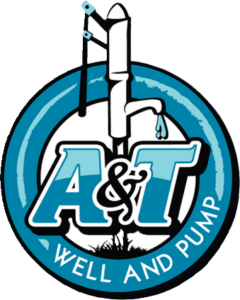Ozone water treatment systems offer a safe way to get rid of iron, bacteria, and…
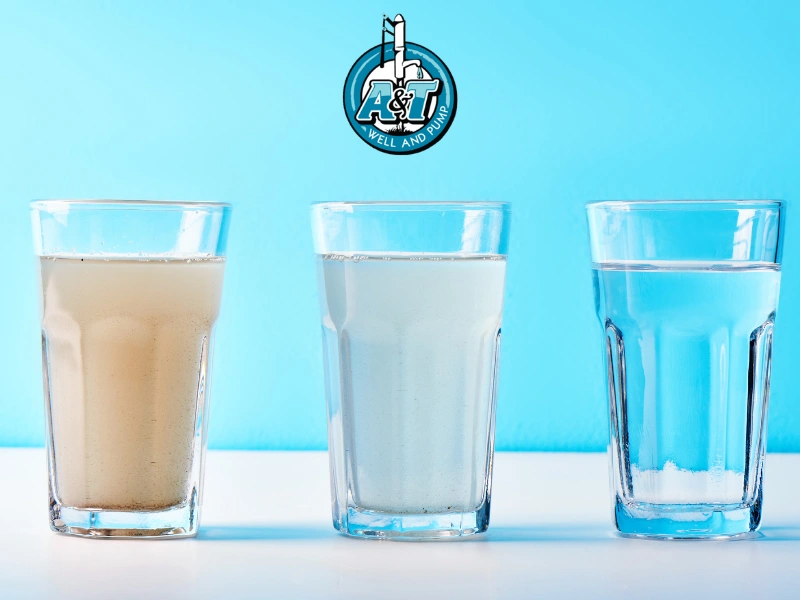
If you rely on a private well in Raleigh, NC, you may notice reddish-brown stains, a metallic taste, or even cloudy tap water. These are common signs that there are high levels of iron present in your water, a problem that affects many well owners across North Carolina. While iron is a naturally occurring element in the earth’s crust, when your home’s well has high iron in water, it can damage plumbing, stain laundry, and reduce overall water quality.
The good news? With the right well water testing and water treatment plan, you can protect your home’s water system and your family’s health.
Table of Contents
What Causes High Iron in Water?
Iron is one of the most common minerals in groundwater, and its presence in well water can come from several different sources. Understanding these causes is the first step toward addressing high iron levels in your home’s water supply.
Naturally Occurring Soil and Rock Formations
As rain falls and filters through shallow soils, it dissolves minerals from the earth’s crust, including iron. This process introduces iron into groundwater, which can then enter wells and cause elevated iron concentration. Because this is a natural occurrence, it’s one of the most common reasons well owners in Raleigh encounter iron problems.
Corroded Plumbing or Pipes
Older plumbing fixtures, iron pipes, and even parts of a well system can corrode over time. As they rust, small particles of ferric iron enter the water system, creating discoloration and staining. This type of contamination often shows up as red water or brown stains in sinks and tubs.
Regional Groundwater Conditions
Some regions, including parts of Raleigh and surrounding North Carolina counties, naturally contain higher levels of iron in groundwater and surface water. Wells in these areas may consistently show high iron content, even with newer plumbing systems. This makes regular water tests essential for monitoring and maintaining water quality.
Why High Iron in Water Is a Problem
Excessive iron in drinking water may not always create a direct human health risk, but it can cause a wide range of issues throughout your home.
Staining and Damage
High iron levels often leave behind reddish-brown stains on sinks, tubs, toilets, and other plumbing fixtures. Laundry can also take on a brown color or streaks that are difficult to remove, even with strong detergents. Over time, this buildup can corrode plumbing fixtures and shorten the lifespan of your appliances.
Taste and Odor Issues
Iron in drinking water creates a metallic taste that affects beverages and food prepared with it. Iron oxidation or bacteria growth may also cause unpleasant odors, making tap water unappealing for everyday use.
Plumbing and Water System Problems
Too much iron in water can clog pipes and reduce water flow throughout the home’s water system. Iron bacteria growth produces slimy buildups that worsen blockages and can harbor harmful bacteria. Water heaters, dishwashers, and washing machines are particularly vulnerable, often experiencing damage or reduced efficiency.
Health and Skin Concerns
Although iron is a nutrient the body can easily absorb from food, excessive amounts in drinking water can cause health concerns. Some people experience skin problems like dryness, irritation, or rashes when bathing in iron-rich water. Ingesting too much iron may also upset the stomach.
Household Cleaning Challenges
Iron doesn’t just stain plumbing fixtures—it also makes everyday cleaning harder. Dishes may come out of the dishwasher with a cloudy film, and glassware can develop spots that are difficult to remove. Even toilets and showers require constant scrubbing to keep brown stains under control.
How to Test for High Iron in Well Water
You may be able to spot signs of too much iron in water, but well water testing is the only way to know how much iron is actually your home's water source.
Visible Indicators
- Brown stains on sinks, laundry, or tubs.
- Metallic taste in drinking water.
- Red water or cloudy discoloration.
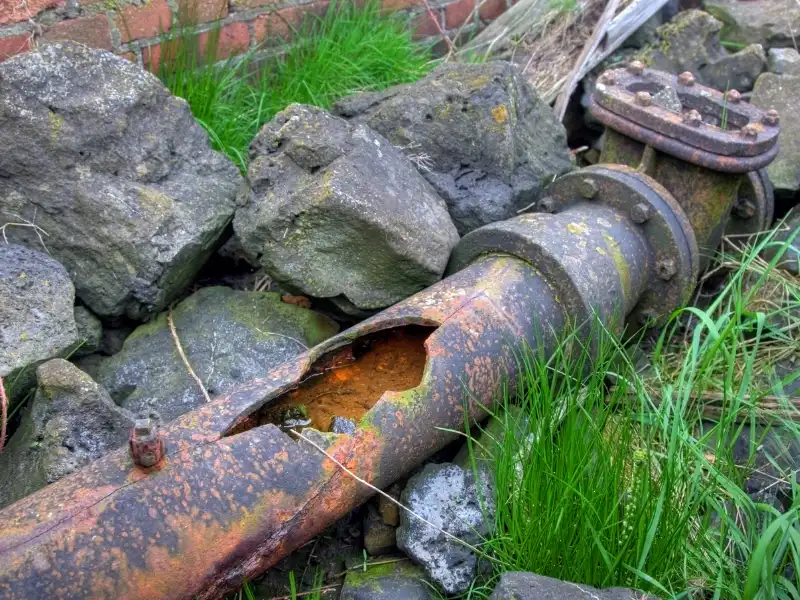

Professional Water Testing
- A laboratory test provides the most accurate results, measuring iron concentration in mg/L (milligrams per liter).
- Testing helps identify the two forms of iron most common in wells:
Ferrous iron (dissolved):
Clear water that turns reddish after exposure to air.
Ferric iron (oxidized):
Visible particles that cause cloudy or red water.
- You should also test for organic iron and iron bacteria, as these may require different treatment methods.
Tip: Contact your local health department or a well water treatment professional for routine water tests at least once a year.
What To Do If There Is Too Much Iron in Your Water
If you suspect excessive iron in your well water, take action quickly to protect your home’s water supply.
Immediate Steps
- Use bottled water or an under sink filter for a short-term solution.
- Avoid using water for drinking or cooking until test results confirm safe iron levels.
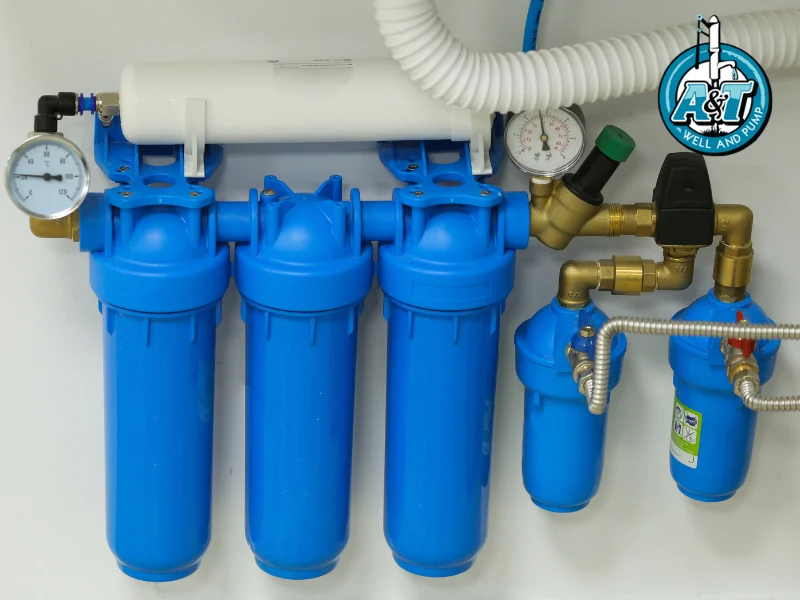
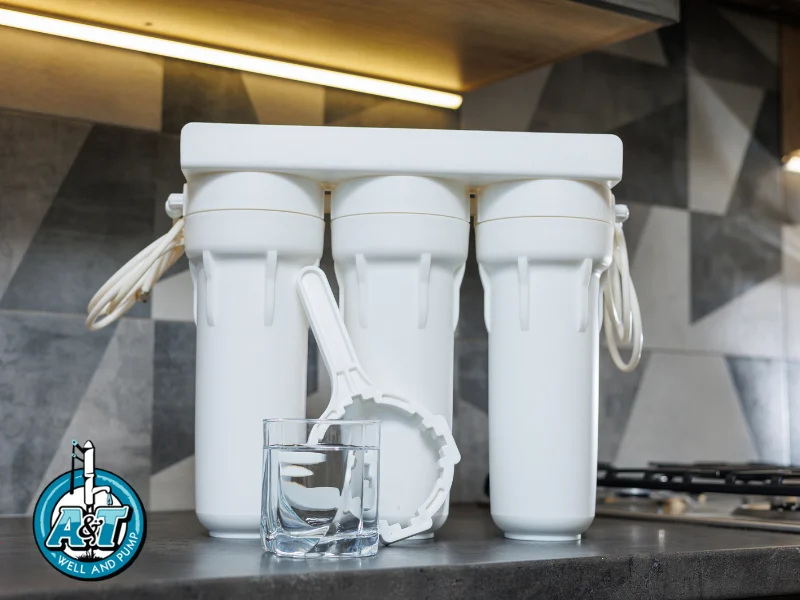
Short-Term Fixes
- Install iron filters that can help with removing iron particles temporarily.
- Shock chlorination may reduce iron bacteria in the well or water system.
Long-Term Solutions
Water softener systems:
Effective for ferrous iron, helping prevent iron oxidation while improving overall water quality.
Oxidation filtration:
Chemical oxidation, aeration systems, or manganese greensand filters can treat ferric iron and organic iron.
Sediment filters:
Trap larger iron particles before they reach your home’s pipes.
Treatment units:
A customized water treatment unit can handle iron and other contaminants together.
Professional inspection:
A licensed water filtration expert can determine the best solution for your well or water system based on water tests.

FAQs About High Iron in Water
Can high iron in water make you sick?
While iron is an essential nutrient and the body can easily absorb iron from food, too much iron in water can cause health concerns such as skin problems or stomach upset. Excessive iron levels can also promote harmful bacteria growth.
Will a water softener remove iron?
Yes, but only for ferrous iron. For ferric iron or iron bacteria, you’ll need specialized iron filters or chemical oxidation systems.
How much iron is too much in drinking water?
The EPA’s secondary maximum contaminant level for iron is 0.3 mg/L. Above this level, water may have taste, staining, and appearance problems.
Is iron bacteria dangerous?
Iron bacteria are not typically a direct health risk, but they can cause water contamination, slime buildup, and unpleasant odors.
How often should I test my well water for iron?
It’s best to test your well at least once a year. If you notice new staining, metallic taste, or red water, schedule additional water tests immediately.
Protect Your Raleigh Well Water with A&T Well and Pump
High iron content doesn’t have to ruin your water quality, appliances, or home’s pipes. With proper testing and treatment, you can resolve iron problems and improve your home’s water supply.
At A&T Well and Pump, our Raleigh water well services include diagnosing and treating iron in drinking water for homes across the Triangle. From water tests to customized treatment units, we’ll help you find the best solution for your iron problem. Contact us today by calling (919) 980-0981 or filling out our online contact below form to get started.
Contact Form
We would love to hear from you! Please fill out this form and we will get back to you shortly.
"*" indicates required fields
